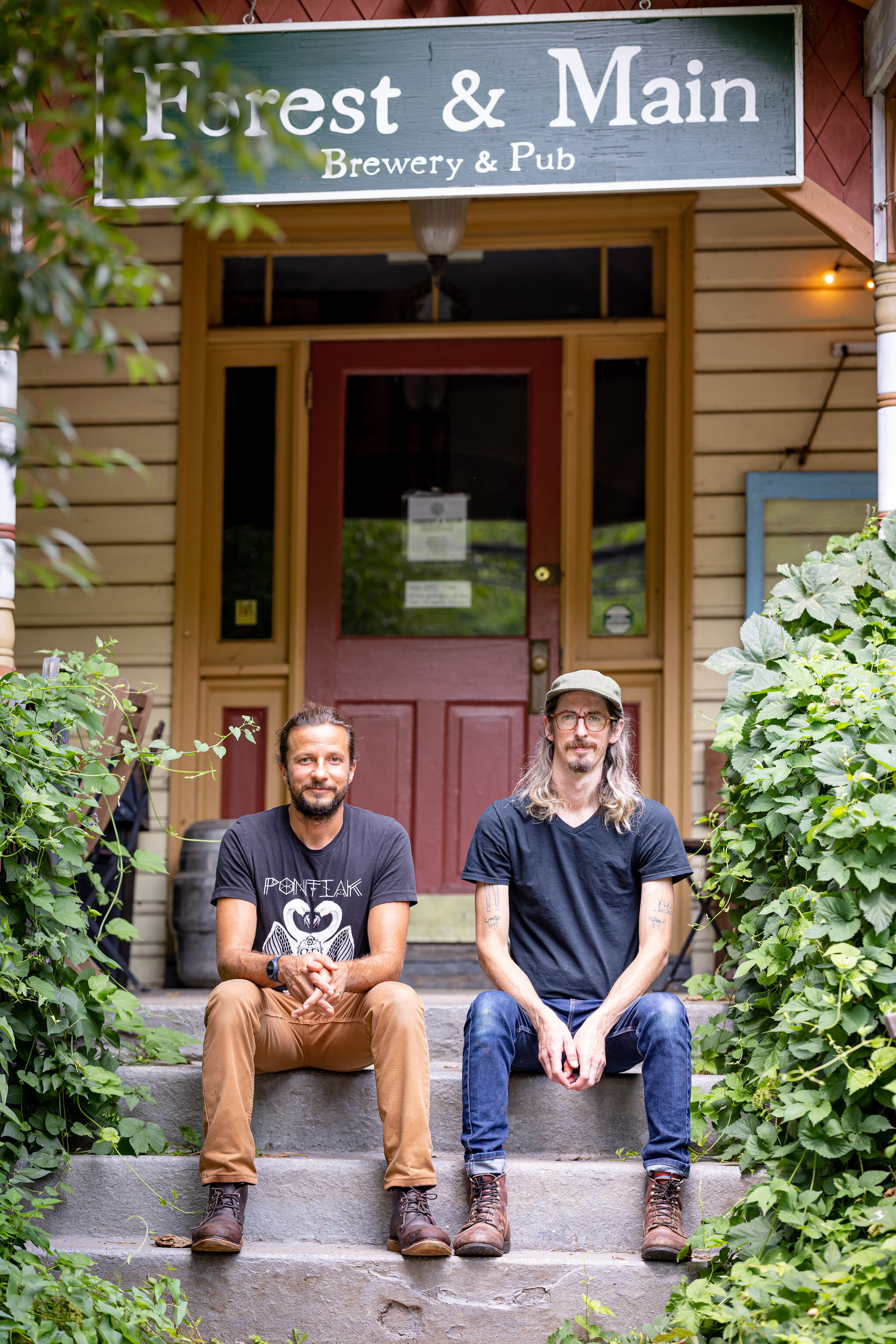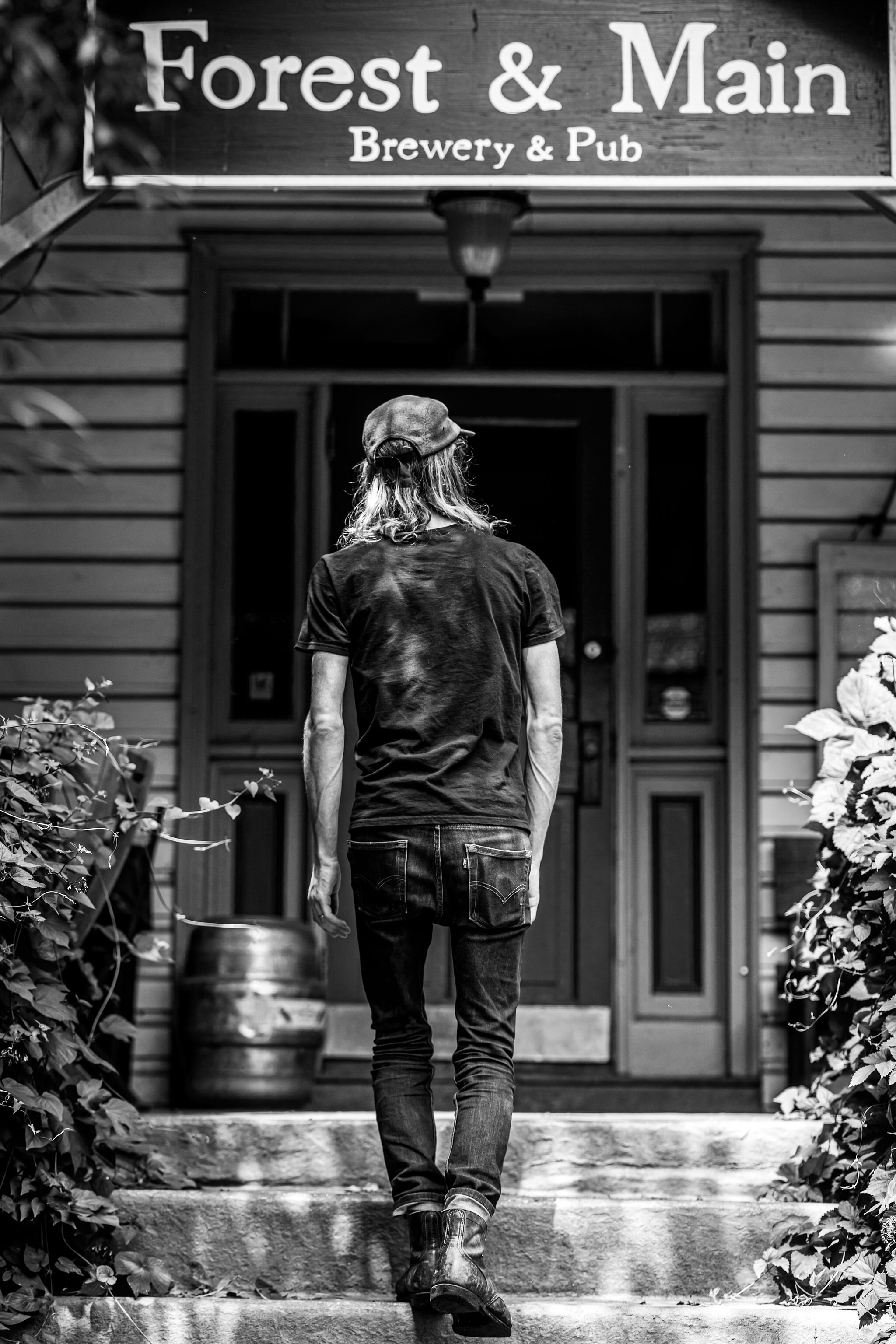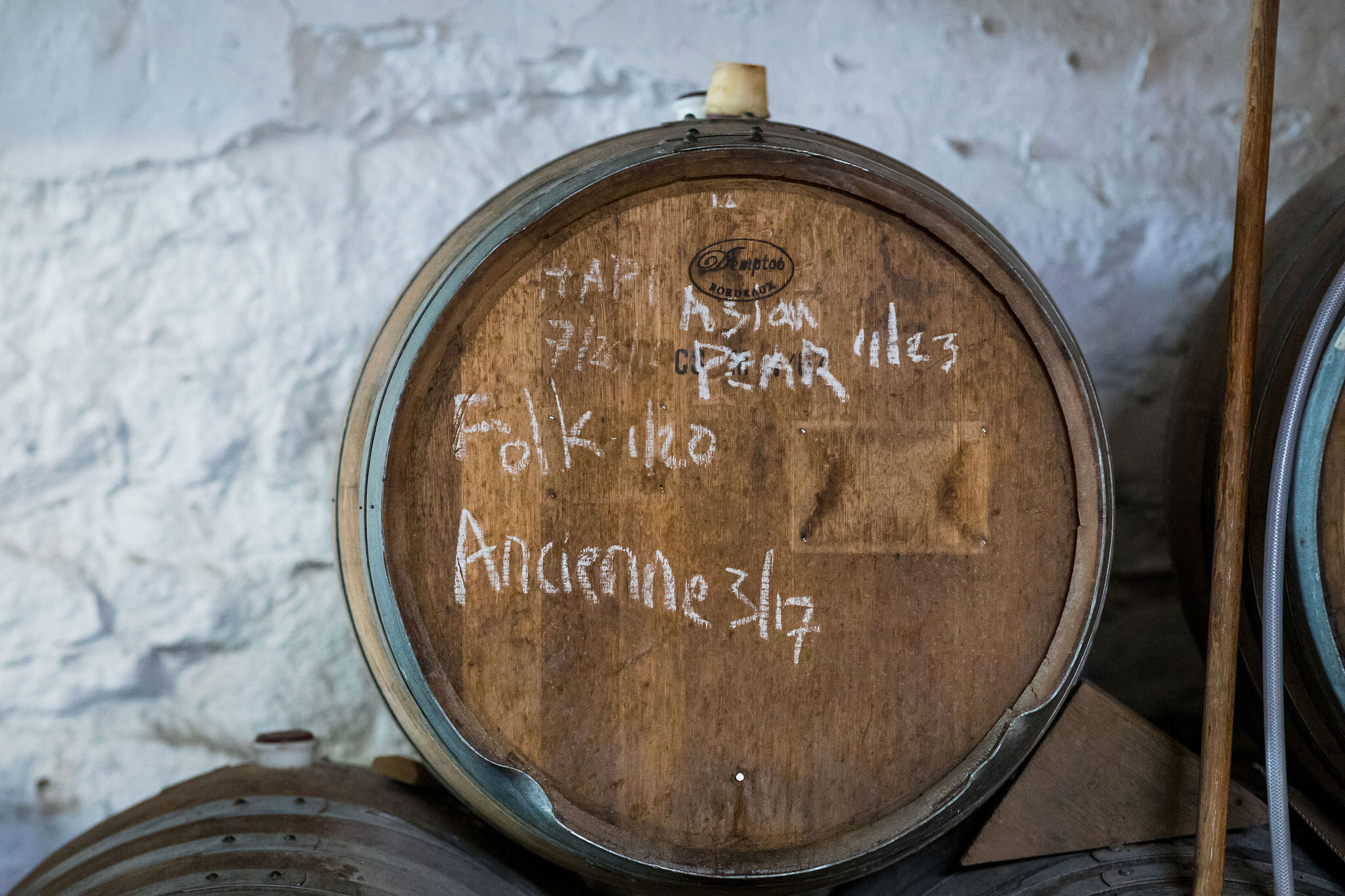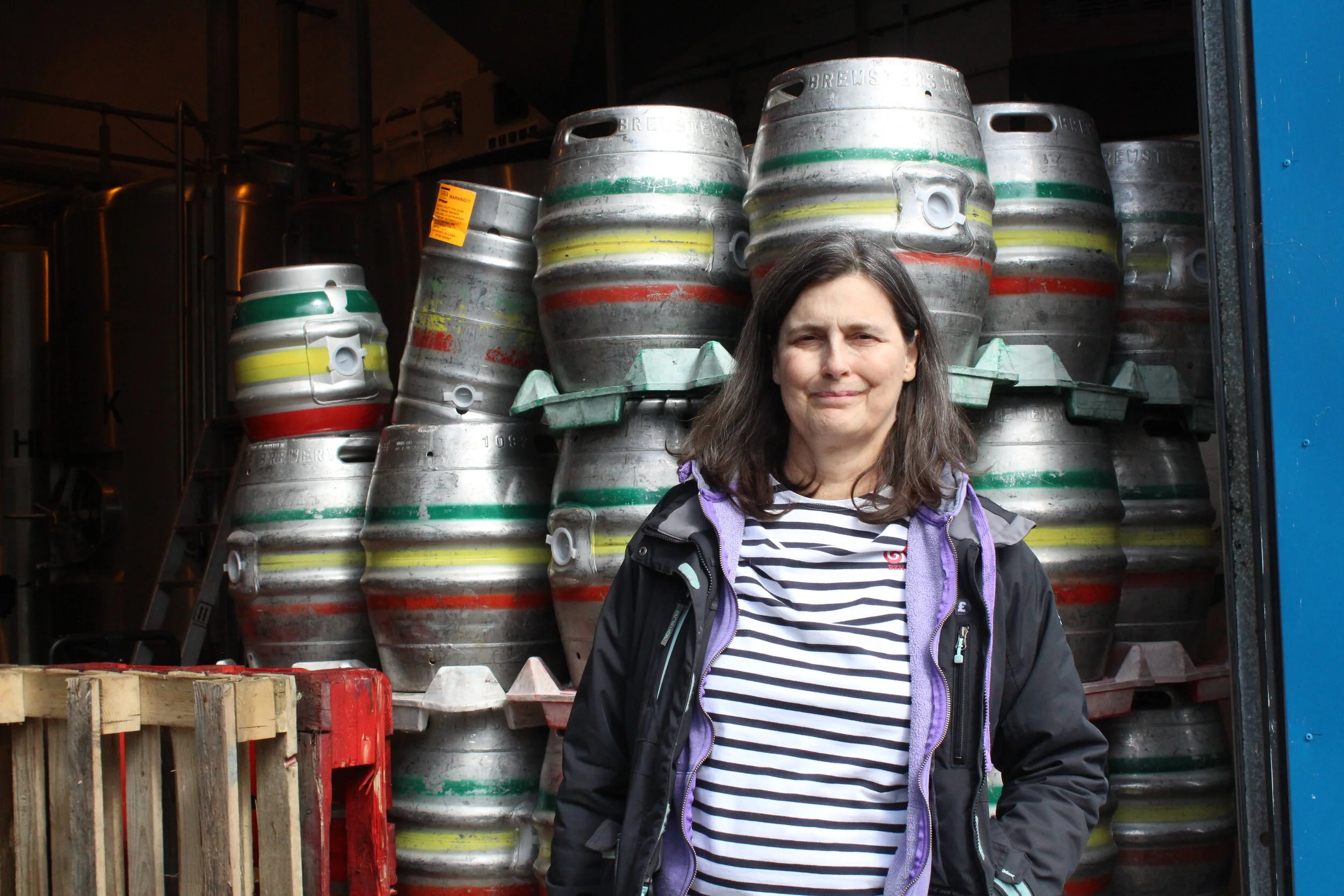From House to Home — Forest & Main Brewing Company, Ambler, Pennsylvania
I first walked into Forest & Main Brewing Company on my 21st birthday. The brewpub opened in my hometown of Ambler in 2012, the same year I became legally allowed to drink in the US. At the time, I was adamant about my distaste for beer. But that minor impediment was outweighed by its convenience as a place to exercise my newly-gifted right to drink without furtiveness.
On that first visit, I ordered a tasting flight, figuring it might increase my chances of finding something palatable. I swiftly handed the first two over to a friend after one sip: the bitterness of the hops puckered my mouth. But the third one—a rich, fruity, Belgian something—showed me that beer had dimension beyond the flat, spoiled stench of a frat house: Eau de Natty Lite. I was hooked.
Photography by Stacey Salter Moore
I owe my epiphany about the spectrum of beer to the passion of Forest & Main’s founders, Dan Endicott and Gerard Olsen. The pair's shared interests in Belgian-style saisons and English-influenced session beers have resulted in a decade-long partnership and endless experiments in flavours and fermentation. They have built off each other’s strengths to create a host of quaffable, lower-alcohol beers as well as a house that feels like home.
***
Everyone I ask about Forest & Main describes the converted 1880s Victorian with some variation of, “like walking into someone’s home.” The cosy rooms, squeaky floors, and worn wood bar varnished by countless elbows create the kind of atmosphere that can’t be bought or curated, only felt.
It’s not just the welcoming creaks and corners of the pub, but the fact that no matter who’s behind the bar (or how much you claim to hate beer), you’ll be met with an enthusiastic recommendation. Despite Forest & Main’s swiftly earned reputation in the craft beer community as a serious, passionate brewery, the pub has continued to welcome everyone from indifferent novices to craft beer acolytes making the pilgrimage to this sleepy Philadelphia suburb.
The house is perched at the corner of Forest and Main Streets in a town whose turn-of-the-century claim to infamy was as “the asbestos capital of the world.” Since then, Ambler has been more happily known for retaining its quirky, small town charm, with a restored 1920’s theatre anchoring a high street populated with long-rooted family businesses.
Dan and Gerard closed the pub space at the start of the pandemic, shifting to delivery and pickup, and the community has missed the space.
“It was really laid back,” Jim Carter, of local distributor Ambler Beverage Exchange, tells me. “You’d see all types of people, you’d get your hipsters, older couples… A lot were local people, so you inevitably knew somebody having a drink there.”
“I loved going there after work,” he adds. “We'd go get a burger, some bacon popcorn, and grab a couple of pints, and it was just a really good spot to relax. I miss it.”
Dan tells me how in the later summer/early autumn of 2020 the hops that grow outside the brewpub covered the empty chairs on the pub’s front porch. Forest & Main started welcoming people back to the porch and yard in April 2021, but the indoor space remains closed.
To Dr. Favian Guertin-Martín, a professor who teaches on criminal justice and craft brewing at nearby Arcadia University, “The bar reminds me of a pub that you would find in an English village…It’s cozy, quaint, small; you go in there and sip your beer and you just chat with folks. Forest & Main kind of embodies that vibe.”
That vibe is exactly what Dan and Gerard were going for. Dan says his time in pubs in the UK taught him the importance of atmosphere, which he describes as about “being with other people—so no TVs, no flashing games, just focusing on enjoying the beer and the company that you're with… When I think of UK pubs, that's the most striking element to me.”
““We made a conscious effort not to try and make it like a British pub, it just sort of happened.””
“One of my all-time favourite pubs that probably subconsciously influenced our design is the Minster Inn, in York,” Dan adds. “Just a cosy little pub with beautiful beer on the hand pumps and friendly locals who took me in like one of their own. No one pub really dictated or inspired [ours] though. We made a conscious effort not to try and make it like a British pub, it just sort of happened in that it’s a small place with none of the trappings of a modern American bar.”
I think it’s because of this that Forest & Main succeeds where so many US “pubs” fail. Dan and Gerard set out to create the homey feeling of an English pub—rather than the Disneyland version, which captures the shell but not the essence of a thing.
“We don’t make it easy for people to like it or to feel comfortable, in a way,” Gerard says. “In the house there’s small old wooden chairs, and the creaky, crooked floor, and the beer is served warmer and not carbonated for the hand-pulled beers, but all these things, it’s… our passions that are coming through and what makes it special.”
The house could only hold 50 people; 70 when spilling onto the front porch. So in 2018 the brewers expanded into the warehouse-style building next door, still referred to by everyone as “the new space.” Though completely different in architecture, it retained the energy of the house next door with low-key live music events.
“To me, a good atmosphere makes you forget about everything outside. And it’s sort of this timelessness at Forest & Main, where it doesn’t seem like you’re in a house from the 1880s, but you’re also not in the present,” Dan says.
I’ve found myself caught in that enveloping bubble often—like the last time I was in, when I caught up with a high school friend and we talked each other’s ears off until close. Despite having moved away several times over (including to the UK, where I found another local to haunt), Forest & Main’s timeless aura always lures me back.
***
Atmosphere is a living thing. Because of people, yes, but also because of the wild yeast that grows almost everywhere. While most breweries rely on commercial yeast to ferment their beers, Forest & Main uses a locally foraged culture in their saisons. The character of these beers quite literally expresses the character of the place.
Gerard forages yeast each spring from the blossoms of the cherry tree in the front yard of the brewery, and the forsythia bush in the back. He hand-collects the flowers and macerates them in a sugar solution, a process that he describes as “very rudimentary” (as opposed to, say, isolating single cells or examining strains under a microscope.) The feeding process continues to bulk up the culture until there’s enough for a batch of beer.
“It’s pretty crazy to think that just a couple cells that were on some flowers in March or April a couple of weeks later turn into a 200-gallon [750 litres] batch of saison,” Gerard tells me.
He describes the early days of the brewery, when “we would be making the same beer over and over again, just with small tweaks because we were just so obsessed with it. ‘What would this four and a half per cent saison taste like with Tettnang [hops] instead of Hallertau Tradition?’ That would be the only difference. In some ways, we'd want to have those two beers on tap at the same time. It'd be pretty redundant for a lot of places but for us, it's like a meditation on the things you're passionate about.”
The constant meditation has made Forest & Main stand out. At Ambler Beverage Exchange, Jim says their beers outsell other local brewers “10-to-1.”
“They basically don't brew the same thing twice…They're always trying to improve, always trying to get creative. Sometimes it's like, that's one of the best beers I've ever drank and then I can't get it again! Because they’ll do something different next week…And I think that's part of the draw. We have people coming in regularly every week, looking for what's new.”
***
When Paul Jones, founder of Cloudwater Brewery in Manchester, first visited Forest & Main, “Dan introduced the brewery as ‘modelled after a traditional English brewpub,’” he says. “When someone says that here [in the UK], it usually means they’re underfunded and a bit of a dump.”
At first, Paul was underwhelmed by the “grundy” equipment—although the repurposed dairy tanks and wood-clad mash tun did, he says, feel similar to a scrappy UK microbrewery. But together with that cobbled-together kit, they made a 100% oat malt beer that Paul admits he “would have been intimidated by… back home.”
Having heard plenty of brewers complain of being held back by their kit, Paul admired Dan and Gerard’s humble ingenuity and work ethic—not to mention the results. He recalls “drinking pints of utterly flawless and delicious traditional cask ale, and bottle samples of some of the best [mixed-fermentation] saison I'd had at that time. And honestly, nobody has really topped Forest & Main in that respect since.”
He also brings up Gerard’s flower-foraged yeast: “There's something deeper than just producing products when that's what you do to make your beer happen, you know?”
““When brewers come from an artistic grounding, I think they approach beer in a very human-centred way.””
Paul explains Forest & Main’s appeal as grounded in both art and community. “Dan and Gerard are both phenomenal creatives,” he says.
“When brewers come from an artistic grounding, I think they approach beer in a very human-centred way...What I see from Dan is someone that is living a really good, holistic, creative life that is also having really good, holistic benefit to friends and family, [and] to the local community.”
Dan creates all the artwork and labels for Forest & Main—each new beer has a distinctive, idiosyncratic label, ranging from graphic line drawings to abstract watercolours. When asked whether the image or the brew comes first, Dan says “it depends on the beer.” For IPAs Dan tends to use brighter, bolder labels; other times he might try to capture the feeling or story of a beer or take inspiration from local scenes. The St. Mary Reserve, a funky, fruity saison fermented with 2020’s foraged culture, features the gates of St. Mary’s Villa, the Scottish Baronial-style castle (some might say folly) built by a local industrialist. The Fourth Wall, a piney, tropical IPA, features—and proceeds benefit—the Ambler Theatre, a town landmark that has been closed throughout the pandemic.
The quirks of Dan’s art and inspiration are a perfect mirror for Forest & Main’s fermentation process: deeply knowledgeable, grounded in the local landscape, and insatiably curious to try something new.
***
The yeast and ferments vary, but the heart of the brewery—their genuine passion for beer, as opposed to business—stays constant. Forest & Main is ever-changing, but never changed. Like my visits home, it’s always both familiar and new.
Dan and Gerard live in the borough with their families, having grown up locally as well. “It feels like we’re part of what Ambler is,” Gerard says.
Forest & Main was at the forefront of a wave of development over the past decade that has seen new businesses fill the classic storefronts, replacing some of the familiar places that populated my childhood. The town continues to change, but I doubt that my feeling of home will ever dissipate.
The brewery is part of that evolution too. Forest & Main recently hired a full-time brewer; while they remain involved with the process, Gerard now focuses on operations, and Dan on art. Having installed a canning line a year before the pandemic, they were able to shift almost seamlessly to selling through distributors and farmer’s markets. And bigger changes are in store: brewing operations will soon move from the pub’s basement to an 8,000 square foot warehouse a few blocks away, with a bar and outdoor deck that will be open on weekends and for special events. The team is excited to expand brewing capacity for their current rotation of IPAs, can-conditioned saisons, and funkier bottled ales.
The pub itself will move to a new space on Butler Avenue, Ambler’s high street, and the original house will close. When I first learned this, I admit, my heart sank. I immediately mourned the loss of my comforting vision of home, and the fact that the familiar would have to become new. But I know that will be followed by the new becoming familiar again—because the spirit of Forest & Main transcends its setting.
Some things stay constant. Like my penchants for Belgian-style wheat beers, finding places that feel homey and low-key, and learning about different flavours and fermentation processes. The ingredients and surroundings may vary— where I live now, I drink mango beer in the backyard and meet up with friends at breweries in converted warehouses scattered in the city’s sprawl. The places I drink, and my definition of “home,” change too. Like all organic and genuine things, Forest & Main continues to grow.

































